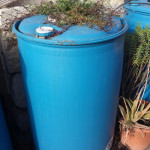Greywater versus blackwater
“Greywater” has been around for as long as humanity. For most of human history they didn’t have a separate term for it — they simply called it “water.” You can be sure that the Chumash and Tongva didn’t chuck their washwater into a code-defined grease pit.
When people hauled water in buckets from a well or creek, there was far too much sweat invested in it to waste it. The phrase “don’t throw the baby out with the bathwater” comes from a time when water was so valuable that the entire family took sequential turns in the same tub full of water, the baby of the family being last in line. Widespread use of greywater in the U.S. has been ongoing since the founding of our country.
In recent decades, over-exuberant scientific specialties have launched a germ phobia. Mega-industries are built around this drive for hyper-sanitation. These have cultivated in an extreme level of paranoia about our water resources. Some people now shun municipal tap water in favor of pricey bottled water (which ironically is subject to less monitoring!). But slowly the pendulum swing is beginning to return from these extremes toward saner and more reasonable policies.
No record of a single documented instance of greywater-transmitted illness has been recorded in the U.S. — Art Ludwig
As we begin to discuss modern greywater, it is important to have a good understanding of three basic definitions: Potable water, Blackwater, and Greywater.
Potable water
Potable water is drinkable water, for instance what comes out of your faucet.
When you run the faucet or shower waiting for the hot water, that initial flow of cold water is potable water. It is clean and there is nothing wrong with it. Catch it in a clean bucket (a technique called “bucketing”) and use it however you please, without any restrictions.
Blackwater
Blackwater is what everyone is afraid of. Toilet water is blackwater. If you wash diapers, or someone in your household has an infectious disease, then your laundry water is blackwater.
Kitchen sink water and dishwasher-water, with its heavy concentrations of oils and grease, is difficult to handle, thus is usually considered blackwater.
Blackwater carries significant potential health hazards, it carries the threat of disease, and thus requires specialized techniques for safety. Never use untreated blackwater in your garden.
Blackwater treatment is best left to the experts. (You can study The Humanure Handbook to begin your own journey toward “expert.”) It is VERY important to keep blackwater entirely separate from greywater.
Greywater
Greywater (also spelled graywater, or gray water) means previously-used water from other sources. Examples include a standard tub of laundry, draining the pasta, scrubbing the carrots, or washing your hands in the bathroom sink.
“50 to 80 percent of residential wastewater is [potential] greywater,” according to the Green LA Coalition Water Team. When used right away, and not stored, greywater is a great resource and can have plenty of uses in your landscape.
Graywater is not potable. If you’re conscious of what goes into the water at the source (post coming soon on graywater soaps), those impurities won’t be anything that healthy soil, with a lively population of soil organisms, can’t handle.
Building codes
With increased population numbers combined with megacity density, keeping the three types of water separate is absolutely imperative to protect the health of the general public.
City building codes are frustratingly restrictive about greywater. Building codes operate based on the very real hazard of blackwater. They are also designed to protect people despite citizen ignorance. The restrictions become more understandable when you realize that most people don’t understand the above basic definitions.
However, armed with a little knowledge your greywater can be plenty safe. Design your systems properly, and you can use greywater abundantly in your landscape.
Greywater is for infiltration
It’s important to remember that graywater is for infiltration purposes only. We want to soak it into the ground, right away, and do so in areas where toddlers aren’t likely to play.
We never try to capture and store greywater for some future use. No storage in barrels for later. Once you’ve been working with graywater for even a short period of time, you’ll realize that a graywater system accumulates small amounts of buildup. This buildup is the reason we don’t ever want to attempt to store graywater. Instead, get that greywater directly into the soil.
This is an excerpt from Water Wisdom by Joanne Poyourow

